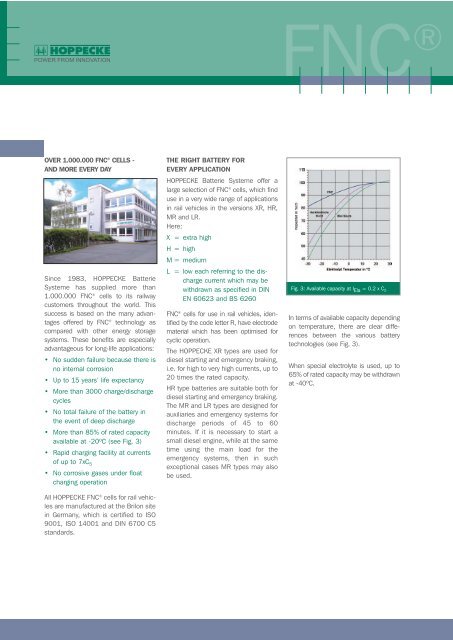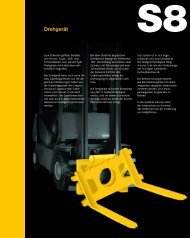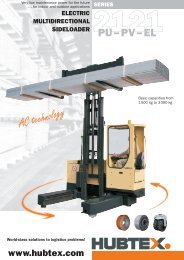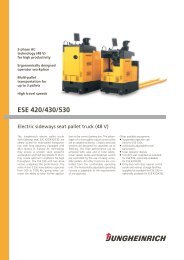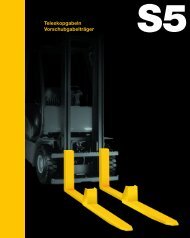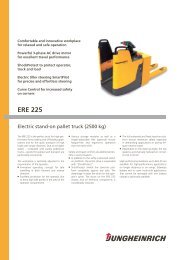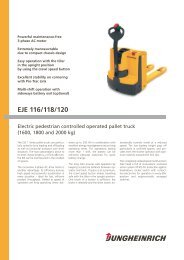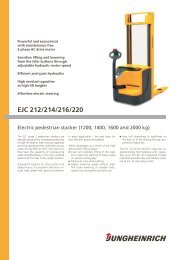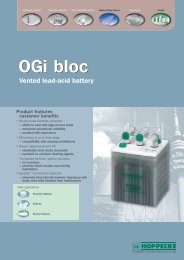FNC® Battery Systems for Rail Vehicles FNC ... - Gothi-bg.com
FNC® Battery Systems for Rail Vehicles FNC ... - Gothi-bg.com
FNC® Battery Systems for Rail Vehicles FNC ... - Gothi-bg.com
You also want an ePaper? Increase the reach of your titles
YUMPU automatically turns print PDFs into web optimized ePapers that Google loves.
<strong>FNC</strong> ®<br />
OVER 1.000.000 <strong>FNC</strong> ® CELLS -<br />
AND MORE EVERY DAY<br />
Since 1983, HOPPECKE Batterie<br />
Systeme has supplied more than<br />
1.000.000 <strong>FNC</strong> ® cells to its railway<br />
customers throughout the world. This<br />
success is based on the many advantages<br />
offered by <strong>FNC</strong> ® technology as<br />
<strong>com</strong>pared with other energy storage<br />
systems. These benefits are especially<br />
advantageous <strong>for</strong> long-life applications:<br />
• No sudden failure because there is<br />
no internal corrosion<br />
• Up to 15 years’ life expectancy<br />
• More than 3000 charge/discharge<br />
cycles<br />
• No total failure of the battery in<br />
the event of deep discharge<br />
• More than 85% of rated capacity<br />
available at -20ºC (see Fig. 3)<br />
• Rapid charging facility at currents<br />
of up to 7xC 5<br />
• No corrosive gases under float<br />
charging operation<br />
All HOPPECKE <strong>FNC</strong> ® cells <strong>for</strong> rail vehicles<br />
are manufactured at the Brilon site<br />
in Germany, which is certified to ISO<br />
9001, ISO 14001 and DIN 6700 C5<br />
standards.<br />
THE RIGHT BATTERY FOR<br />
EVERY APPLICATION<br />
HOPPECKE Batterie Systeme offer a<br />
large selection of <strong>FNC</strong> ® cells, which find<br />
use in a very wide range of applications<br />
in rail vehicles in the versions XR, HR,<br />
MR and LR.<br />
Here:<br />
X = extra high<br />
H = high<br />
M = medium<br />
L = low each referring to the discharge<br />
current which may be<br />
withdrawn as specified in DIN<br />
EN 60623 and BS 6260<br />
<strong>FNC</strong> ® cells <strong>for</strong> use in rail vehicles, identified<br />
by the code letter R, have electrode<br />
material which has been optimised <strong>for</strong><br />
cyclic operation.<br />
The HOPPECKE XR types are used <strong>for</strong><br />
diesel starting and emergency braking,<br />
i.e. <strong>for</strong> high to very high currents, up to<br />
20 times the rated capacity.<br />
HR type batteries are suitable both <strong>for</strong><br />
diesel starting and emergency braking.<br />
The MR and LR types are designed <strong>for</strong><br />
auxiliaries and emergency systems <strong>for</strong><br />
discharge periods of 45 to 60<br />
minutes. If it is necessary to start a<br />
small diesel engine, while at the same<br />
time using the main load <strong>for</strong> the<br />
emergency systems, then in such<br />
exceptional cases MR types may also<br />
be used.<br />
Fig. 3: Available capacity at I Ela = 0.2 x C 5<br />
In terms of available capacity depending<br />
on temperature, there are clear differences<br />
between the various battery<br />
technologies (see Fig. 3).<br />
When special electrolyte is used, up to<br />
65% of rated capacity may be withdrawn<br />
at -40ºC.


